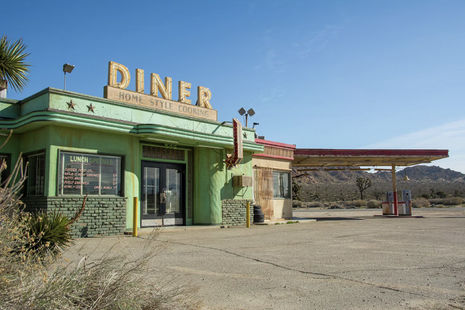Looking to the stars with Wes Anderson’s Asteroid City
The latest from TikTok’s favourite auteur is a meticulously detailed, if occasionally impenetrable, tale of cosmic dread

Why are we all so mad about Wes? I can’t be the only one who finds it a little baffling that a director whose latest work has only become less accessible for mainstream audiences, has also recently become a kind of digital household name. It requires very little scrolling on social media before one discovers a wealth of Anderson pastiches, from AI-concocted trailers to homemade vlogs of day-to-day rituals, all aimed at mimicking the director’s notorious eye for aesthetic neatness and pastel-tinged symmetry. Anderson’s latest offering, the wonderfully weird (and sometimes weirdly wonderful) Asteroid City is, then, something of a test. Does the world of Wes amount to little more than a handsomely assembled house of cards, easily reproducible by iPhone-wielding teenagers, hungry for hits? Or, as we peel back the layers of carefully constructed artifice, is there something more to be found beneath his films’ pretty surfaces?
With Asteroid City, the task is particularly hard, if only because there are simply so many layers at play. From the outset, we’re informed that we’re watching a televised production from the 1950s of a fictional play entitled “Asteroid City”. The play tells the story of a youth astronomy convention taking place in an isolated desert town, soon plunged into a government-enforced quarantine (sound familiar?) after a close encounter of the third kind (no pun intended – Spielberg is, doubtless, a major touchstone here). Bryan Cranston stands at the helm of another narrative strand, starring as the host of a fictional documentary that purports to offer a behind-the-scenes look at the tumultuous original production of “Asteroid City” on the New York stage.
If there are clear ways to discern between the textual layers (the televised version of the play is, not least, shot in widescreen colour, the documentary, in a tight black-and-white Academy ratio), there’s still a fair amount of metafictive disentangling to be done. Take, for instance, Scarlett Johansson’s Midge Campbell, a character in the play written as an aloof actress who reluctantly accompanies her daughter to the space convention. But, of course, Johansson also takes on the role of Mercedes Ford in the black-and-white sections of the film, the actress starring as Midge. So, we have an actress playing an actress playing an actress – even by Anderson’s standards, this is some hefty conceptual density. Yet, it’s an elaborate framing device which never feels quite as well-oiled as it should do; besides a haunting monochrome cameo from Margot Robbie, much of the fun is found instead in the film’s more colourful segments.
“even by Anderson’s standards, this is some hefty conceptual density”
In the boxed-in world of Asteroid City, we’re coaxed into a very different kind of stargazing than that pursued by the young “space cadets”. A vast rostra of famous faces invariably lurks around every corner, from Anderson regulars (Jason Schwartzman, Jeffrey Wright, Tilda Swinton) to some notable first-timers (the standout amongst them is Tom Hanks, in perhaps his gruffest paternal role to date). If we’re in danger of becoming overwhelmed, the film’s characteristically arch dialogue places the various working parts of the ensemble on something of an even keel. As in all of Anderson’s work, everyone here talks exactly like him – a fact that is, at times, quaintly charming, and at others, more than a little navel-gazing.
The world of the film is as mannered and stylised as one would expect, but, perhaps uniquely in Anderson’s corpus, it’s one that also feels distinctly shakeable. Where Ralph Fiennes’ Gustave H. is able to stand in confident command of every corridor of the Grand Budapest Hotel, the itinerant inhabitants of Asteroid City are unmoored, against their will, in an unfamiliar place. Beyond the deliberate doll’s house aesthetic, it’s a world that feels inherently counterfeit and impermanent, populated by two-dimensional shop fronts or unfinished runways that, rather amusingly, lead to ‘nowhere’. Suitable to the film’s metatextual trappings, the Asteroid City of Asteroid City ends up resembling, more often than not, a film set.
“a vast rostra of famous faces invariably lurks around every corner”
The characters themselves seem to similarly exist on tenterhooks, all desperately seeking to find their bearings in a world where reliable truths seem prone to vanishing into thin air. Men randomly carry guns on their belts; the booming reverberations of atomic bomb tests echo, with haunting regularity, through the sandscape, accompanied by the sudden screeches of hot rod car chases. This is an anxious world, one where nobody is ever allowed to be fully at ease. “I don’t like the way that guy looked at us”, says Schwartzman’s Augie Steenbeck, shortly after the film’s central epiphany (one that comes, quite literally, from above) – “like we’re doomed”. “Maybe we are”, Midge replies, with a vacantness that initially reads as nonchalant, but belies a bitter aftertaste of despair.
I’ve always found that Anderson’s films cry out to be watched a second time; there’s simply too much detail in every frame and too many words a minute to fully take it all in with a single viewing. Indeed, the film gives a self-reflexive nod towards its own inscrutabilities, as an actor nervously confesses that he still doesn’t understand the “meaning” of the fictional play, only for Adrien Brody’s director to reassure him that he need do only one thing: “just keep telling the story”. It’s an artistic mantra certainly taken on by Anderson himself, who’s never in the business of overexplication, and appears stubbornly reluctant to kowtow to mainstream tastes by softening his singular style. Self-indulgent instincts and all, it’s a boldness that proves to be just enough for Asteroid City to remain airborne.
Asteroid City is in cinemas now.
 News / Cambridge postgrad re-elected as City councillor4 May 2024
News / Cambridge postgrad re-elected as City councillor4 May 2024 News / Gender attainment gap to be excluded from Cambridge access report3 May 2024
News / Gender attainment gap to be excluded from Cambridge access report3 May 2024 News / Some supervisors’ effective pay rate £3 below living wage, new report finds5 May 2024
News / Some supervisors’ effective pay rate £3 below living wage, new report finds5 May 2024 News / Academics call for Cambridge to drop investigation into ‘race realist’ fellow2 May 2024
News / Academics call for Cambridge to drop investigation into ‘race realist’ fellow2 May 2024 Comment / Accepting black people into Cambridge is not an act of discrimination3 May 2024
Comment / Accepting black people into Cambridge is not an act of discrimination3 May 2024






